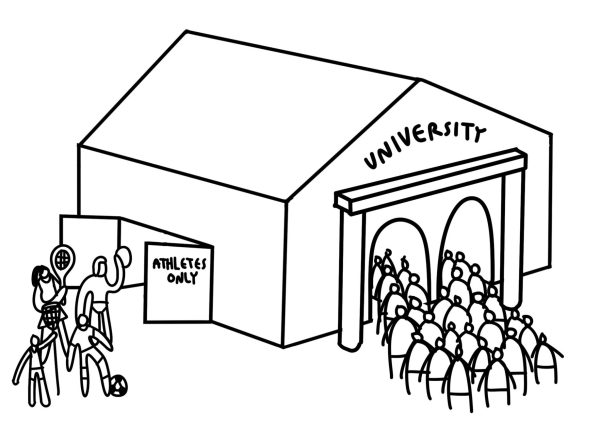I am not invisible: It is time for MENA to be added to the U.S. Census
March 3, 2023
“White, Black or African American, American Indian or Alaska Native, Asian, Native American, Native Hawaiian or Other Pacific Islander or Other.” I read the list again; I am unsure of what option to select. I am half Lebanese and half white, but there is no category for people like me.
Racial and ethnic categories are generally modeled after the United States Census, which states that Middle Eastern and North African (MENA) people are classified as white. However, this categorization is inaccurate and inappropriate. MENA needs to be added to the U.S. Census as a racial and ethnic category in order to properly reflect people’s identities and lived experiences and provide equal opportunities to education, housing and other resources.

Until the Immigration and Nationality Act of 1965 was passed, it was very difficult for MENA people to become U.S. citizens because the U.S. had imposed a quota system that significantly restricted the number of Asian people, including people from the MENA region, who could immigrate to the U.S. Thus, for many years, MENA people argued that they were white for the sole purpose of gaining United States citizenship.
Now that citizenship laws have changed, MENA people have begun to reclaim their identity and demand their own category on the census. This is important because census data is used to determine the use of $675 billion in federal funds to states and communities for health, education, housing, employment, small business loans and more. Without our own category, MENA people cannot benefit from or influence this funding.
When given the option to select MENA as a racial category, most MENA people select it over white. According to a study published in the Proceedings of the National Academy of Sciences of the United States of America, when given the current U.S. Census race options, 80 percent of MENA participants selected white, five percent selected Asian and 15 percent selected “some other race.” However, when given the current U.S. Census race options in addition to a MENA option, 87 percent selected MENA as at least one of their racial categories and 11 percent selected white. The results show a clear conclusion: MENA people do not identify as white.
MENA people face challenges that most white people do not have to face and, as such, their lived experiences are often different from their white counterparts. Many MENA people experience racial discrimination similar to that of other minority groups. For example, stereotyping and profiling of MENA people became especially prominent after the 9/11 attacks because the terrorists involved in the attack were of Middle Eastern descent. Furthermore, many MENA people are immigrants or children of immigrants, which poses its own set of unique challenges. According to the Migration Policy Institute, the United States is home to an estimated 1.3 million MENA migrants and refugees and many struggle to access health care and housing and face significant language barriers. Language barriers further exacerbate their challenges, making it difficult to succeed in school and get a good job.
During a House of Representatives Oversight and Reform Committee meeting, Congresswomen Rashida Tlaib addressed the Census Bureau Director, arguing that MENA needs to be added to the census.
“Would circling white on the census change my lived experience as a person of color in our country?” Tlaib said. “I am not white. I’m not. And I don’t try to say to others that you should be this or that. But when I sit on this form and I look at it, I don’t see myself represented on this form. And I think that’s a huge issue for people like me.”
By saying that they are white, we’re not acknowledging the challenges MENA people face and are depriving them of valuable resources.
The lack of a MENA category also prevents schools and places of work from ensuring that they have diverse student bodies or workplaces. The majority of forms in the United States base racial and ethnic categories off of the U.S. Census. For example, the Common Application, a platform used widely by students in order to apply to multiple colleges at once, uses the same racial categories as the census. When MENA people are considered white on applications, schools cannot determine the true ethnic and racial makeup of their student bodies. Consequently, schools cannot ensure that their student bodies are sufficiently diverse.
When registering for school at Redwood, parents have to select a race and ethnicity for their child. While the administration has taken steps in the right direction by including more racial categories (specifically by including multiple Asian and Pacific Islander categories), MENA is still not an option.
In 2021, the Tamalpais Union High School District (TUHSD) Board approved a new Racial Equity Policy. The policy states that “TUHSD shall also pursue inclusiveness in its curricular and extracurricular courses and activities in order to ensure that TUHSD students have equitable access to TUHSD programs, supports, and services.” However, without including MENA in their forms and surveys, the district can’t ensure that MENA students have equitable representation in TUHSD programs and services.
If the census included MENA as a racial and ethnic category, it would give individuals the option to more accurately reflect their identity. By excluding the MENA category on the census, the U.S. government is essentially erasing an entire group of people and depriving them of the resources and representation they deserve. As Congresswoman Tlaib said to the director of the U.S. Census Bureau, “You are making us invisible.”






















